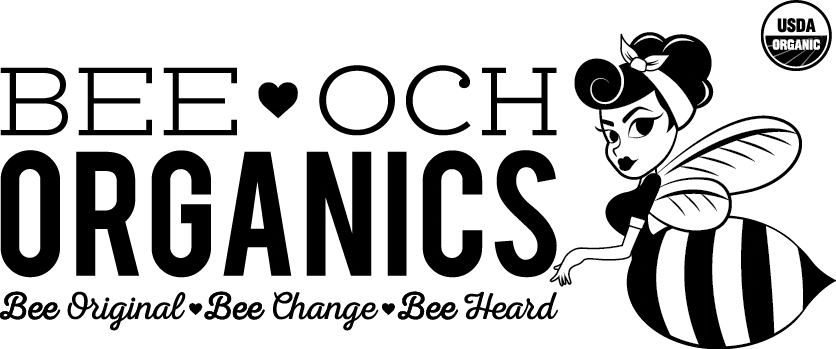Hey, babe, it’s Brooke, your queen bee! I’m writing directly from the BEE-OCH Hive in Fort Lupton, Colorado with more nerdy skin science!
A little buzzing bee told me that you’ve been stressing about those annoying dark spots that keep popping up on your skin and face.
Those dark spots you refuse to ignore are called “lentigo”, which is a weird word that no one’s ever heard of for “sunspots” (also called liver spots, or age spots).
So now, we’ve got four words for it, but I’ll just use sunspots because it’s much more telling of the root cause of them.
And if you’re going to treat something, you better be working on both the symptoms AND the prevention (the root cause) or you’re wasting your time.
Alright, so strap in for this…
Are you ready?…
You sure?….
Sunspots are caused by….
Wait for it…
By the sun!
That means the very first and best thing you can do on the preventative side of treating sunspots is to simply wear sunscreen.
Easy peasy, right? (If you need a quick lesson on which sunscreens are safest and which ones to leave behind, read more here. Or skip right to our Tinted Mineral Foundation Sticks that contain 31% natural sunscreen minerals!)
But how do sunspots come from the sun?
Sunspots appear through a process called melanogenesis. The word is quite literal as most big science words are: “Melano” means melanin, and “genesis” means origin = origin of melanin.
Melanin is the dark pigment protein that make up your sunspots within your skin.
The creation of melanin takes place inside melano-cytes. Can you guess what those are? Yep, you’re right. They are the skin cells responsible for making melanin.
They do so by creating melano-somes, which are pigment granules that carry the protein melanin.
The star-shaped, branching arms of the melanocytes help the cells transfer melanin from the melanosomes (pigment granules) into nearby cells called keratinocytes (the main type of cells in our skin, hair, and nails).
Melanocytes can take all the credit for your summer tan and helping protect your skin cells from sunburn.
Melanin works by shielding deeper cells from the sun just like putting on a pair of sunglasses – thank you melanocytes!
But wait, I’m very concerned… you didn’t think you’d get off that easy, did you? Very few good things come without a price, and some automatic skin cell protection is no exception!
Unfortunately, melanin can become semi-permanent “sunspots” if they are deposited in irregular clumps into our skin cells.
As we age, sunspots tend to hang around for several reasons including reduced cell turnover, reduced skin thickness, and a lifetime of UV exposure.
So, now we know where and what produces sunspots, but how it happens is the most important for our purposes. Here’s where it gets buzzy, so pay attention!
Melanocytes are triggered to produce melanosomes because of inflammation in the skin. Inflammation can be caused by UV exposure, acne, physical trauma, and a crappy diet.
When a melanocyte makes melanin, it does so by converting the amino acid tyrosin into the protein melanin using an enzyme called tyrosinase – the same enzyme responsible for turning an apple brown!
Science tip, if you see a word ending in “ase”, it usually indicates an enzyme. That means our melanin-producing cells do so with the help of an enzyme!
Ah ha! Here’s our opportunity!
If we can stop the action of melanocytes converting tyrosin into melanin (aka stop the tyrosinase enzyme), we can stop the depositing of melanin into keratinocytes, and voila! We stopped the creation of new sunspots in our skin!
Ok, so how do we stop the tyrosinase enzyme?
We do this using something called a tyrosinase inhibitor. Yep, it’s that simple.
A tyrosinase inhibitor is exactly how it sounds. It inhibits (or prevents) the action of tyrosinase!
As an analogy, think about the United States Postal Service as being “melanogensis”…
Imagine you’re the mail carrier (the melanocyte) and you have a large package that’s filled with girl scout cookies (melanin) to deliver to a nearby house (keratinocytes).
Still with me??…
Ok, so in order to get that package to it’s destination, you have to use your mail truck (tyrosin).
But the mail truck doesn’t run without natural gas. So, you fill the tank with gas (tyrosinase) and it fires right up so you can get those cookies to their destination.
But if someone pours sugar in the mail truck gas tank you definitely aren’t getting very far. (Wait, is sugar in the gas tank even a thing? I feel like I’ve seen it in a movie once…)
Anyway! Think of the sugar in the tank as being our tyrosinase inhibitor. There is no chance that your girl scout cookies (melanin) are going to make it to that house to be deposited into the mailbox (keratinocytes)!
Now usually sugar in the gas tank isn’t favorable (and I’d be pretty upset if I was waiting on my cookies), but for our purposes that’s what we need to do!
Lucky for us, there are lots of natural and organic ingredients that are tyrosinase inhibitors and act like sugar in our melanocyte’s gas tank.
Some common tyrosinase inhibitors that you’ve likely heard of are:
• Vitamin C
• Retinol
• Carrier oils like Sunflower, Safflower, and Pumpkin Seed Oil that have high linoleic acid content (Oleic vs Linoleic Oil is a subject all its own so I’ll save that for another time.)
Now listen, I’m all for graceful aging. Because damn, it looks good on you! But you want to know a secret?
You don’t have to go out to the store and find yourself an insanely expensive jar of toxic chemicals with maybe a pinch of vitamin c and retinol in it.
You can get all the benefits of tyrosinase inhibitors AND get potent products AND avoid toxic preservatives AND support your skin’s healthy skin barrier AND not overpay for mainly water in a jar.
Because we make 100% clean and organic products that check all FIVE of these ingredient boxes right here at BEE-OCH!
Our Organic Body Butter is my personal favorite and is the ultimate hand and foot cream! It’s made for those of you who have tried everything to relieve super dry or inflamed skin!
It’s made with the sunspot-fighting organic sunflower, safflower AND pumpkin seed oils with the added bonus of natural AHAs (alpha-hydroxy-acid) PLUS organic beeswax to seal in moisture and help it last through several hand washings WITHOUT being greasy.
Don’t believe me? Put it to the test!
Next is our Vitamin C + Peptide Facial Toner and my goodness if you are just so fed up with your skin and ready to fall back in love with it, I could write a whole book on it’s benefits.
For now, I’ll tell you that not only does Vitamin C prevent melanin formation, but combined with peptides provide the essential building blocks for collagen in your skin!
If you remember from my collagen blog, collagen is the protein in your skin responsible for skin firmness, elasticity and the appearance of (or lack thereof) wrinkles.
Finally, our Retinol Roller is the key to it all! Retinol also has its own dedicated explanation, but it’s mainly important to mention that retinol acts as a tyrosinase inhibitor AND is shown to increase cell turnover.
This is a double whammy for sunspots! It’s not only helping prevent sunspot formation, but it can help bring your current sunspots to the surface faster, thereby helping them disappear more quickly than tyrosinase inhibitors on their own!
The best part? You can easily roll-on sunspots and wrinkles directly target the areas you’re concerned about! This helps conserve product and help your actives work more efficiently!
So what are you waiting for? Now you’ve got the knowledge AND the tools to kick some sunspot butt!
In bee-auty AND health,
Brooke





